The Very BEST Whole Wheat Bread
The Very BEST Whole Wheat Bread is the softest, moistest, fluffiest, freshest-staying, homemade, 100% whole wheat bread you've ever tried!
This bread, y'all. This bread. I titled this Whole Wheat Bread recipe "the BEST" and I'm not even exaggerating here. I've baked many a whole wheat bread recipe over the years, and this one is head-and-shoulders above the rest.
Hundreds of raving comments (since I first published this recipe six years ago) can't be wrong...right?! So I decided to update this old post with tons of additional information and tips to help ensure your bread making success!
THE BEST Whole Wheat Bread
Here's the deal...what makes this bread so amazing is that it stays soft and fresh for days after it's been baked.
Just about all homemade bread tastes fabulous fresh out of the oven. But then whatever isn't initially eaten tends to dry out a bit as the days stretch on, particularly in the case of wheat bread.
But this bread is just as good on the third day (if it lasts that long!) as it was on the first. Seriously! I wouldn't believe it if I hadn't experienced it first hand myself. It's like store-bought, stay-soft bread without the preservatives. Forgive me for going all Scarlett O'Hara on you, but as God is my witness, I'll never make another whole wheat bread recipe again!
The Best Whole Wheat Flour for Bread Baking
One of my bread making tricks is that I like to use white whole wheat flour when I make bread. Even though it has the word "white" in its title, this flour is 100% whole wheat.
Traditional whole wheat flour is milled from red wheat; white whole wheat flour is milled from (hard) white wheat. Its lighter grain results in a milder flavor and lighter texture than the whole wheat flour to which most of us are accustomed.
Don't be fooled by the taste, though...white whole wheat flour is unrefined and 100% whole wheat! It's nutritionally the same as its red wheat cousin. I buy King Arthur brand unbleached white whole wheat flour, but I'm sure there are other brands out there that would work just as well.
How to Make the Best Whole Wheat Bread
Not only does this whole wheat bread turn out better than most, but the recipe is actually simpler to make than most! Some of the steps may seem a bit unconventional to an experienced bread maker. But if you give this recipe a chance, I think you'll be pleased with the results.
- Fit your stand mixer with a dough hook. Measure out flour, vital wheat gluten, and instant dry yeast into the bowl and mix until combined.
- Pour in very warm water (between 120°F and 130°F) and mix for one minute. The water needs to be hot enough to activate the yeast but not so hot that it kills it.
Cover with a clean kitchen towel and allow to rest for 10 minutes.
- Uncover the bowl.
Beat in salt, oil, honey, and lemon juice.
- Add more flour, mixing it in one cup at a time until well incorporated. Allow the dough hook to knead the dough until it becomes smooth instead of sticky and pulls away from the side of the bowl.
This typically takes 10 to 15 minutes but may take as little as 5 minutes.
- Grease and/or line your pans and set aside.
- Turn on the oven to 350°F. After exactly one minute, turn it back off. This will preheat the oven to lukewarm...just enough to give your loaves the perfect warm spot to rise!
- Turn the dough out onto a greased surface.
Divide it equally in half and shape it into two loaves.
Transfer the loaves to the prepared bread pans, pressing the dough into the corners.
- Place the pans in the warm oven and allow them to rise for 20 to 40 minutes, or until they are nicely domed and as high as you wish your final whole wheat bread loaves to be.
- Once the loaves have risen to your liking, turn on the oven to 350°F WITHOUT TAKING THE BREAD OUT OF THE OVEN. Set the timer for 30 minutes. I know, I know...sounds weird. But trust me.
- Your bread is done when it's golden brown on top with an internal temperature from 190°F to 200°F on an instant-read thermometer. Turn the hot loaves out onto a rack to cool completely.
And that's it. One step at a time...you can do this!
What's a Bread Sponge?
Let's talk about step #2 for a moment, shall we? I believe that the biggest factor that makes this bread stay so soft and fresh is the step in the recipe calling for you to make a sponge. Now I'm not talking about the kind of sponge you keep by your kitchen sink. In bread making, a sponge is a very moist dough that just begins to rise as it gives the yeast a head start. After it's had some time to do its magic, you add more flour and ingredients and proceed with the recipe. The sponge in this recipe only needs to sit for about 10 minutes. But apparently that's all it takes to achieve this bread's wonderful texture.
Ingredient Substitutions
For optimal results, make this whole wheat bread as directed. However, the recipe will still work (and even turn out great) incorporating a variety of substitutes. Just keep in mind that changing the ingredients may result in a different taste and/or texture in your final loaves. Switching ingredients could also require you to tweak an amount or a step, such as needing to add extra flour and/or kneading a bit longer to achieve the proper dough consistency. But if you're willing to experiment a bit, people have had success with the following substitutions...
(NOTE: Many of the below recipe tweaks have been taken from the comment section. I have not tried all of these substitutes myself.)
- Flour. You can make this recipe with regular (as opposed to "white") whole wheat flour. Or you may substitute all-purpose white flour for around half of the whole wheat flour. You may also use freshly ground whole wheat flour (milled from red wheat or white wheat). Just keep in mind that fresh milled flour is much "airier," so you may need to allow it some time to pack down before measuring it out...or just plan on using extra flour, as necesary. Also, with any flour substitution, you may need to slightly adjust the amount of flour added at the end of the recipe. For example, if the dough seems extra sticky and doesn't start pulling away from the bowl in a timely manner, you can work in additional flour (one spoonful at a time) until the texture seems right.
- Vital Wheat Gluten. This ingredient helps whole wheat bread recipes rise, and it encourages soft and chewy loaves with that stay-fresh quality. That being said, if you don't have any on hand or prefer not to use it, many people report having made this bread successfully while leaving out the vital wheat gluten.
- Yeast. I recommend using instant dry yeast (sometimes called "quick rise" or "rapid rise"), as directed in the recipe. You might have success if trying regular active dry yeast...but then again, maybe not. 😉 If you do decide to gamble on active dry yeast, my research indicates that to substitute it for instant dry yeast, you should multiply the amount by 1.25.
- Lemon Juice. If you don't have any lemon juice on hand, you may substitute another type of acid in its place. Orange juice, white vinegar, or apple cider vinegar would all work.
- Honey. You may reduce the honey, if you wish. Also, maple syrup or agave may be substituted for the honey.
Other Recipe Notes
- The stand mixer pictured in this post is a classic, 5-quart, tilt-head KitchenAid.
- You may halve this recipe to make only one loaf of bread.
- You can also make this bread by hand...just prepare your muscles for all of that kneading.
- People have also reported success in halving the ingredients and making this recipe in a bread maker. But I don't own a bread maker and I'm not sure of the specifics...so you may have to experiment on that one. 😉
Avoiding Sticking
The only difficulty that I ran into the first time I made this bread is that it stuck to my loaf pans, despite the fact that I had generously greased them. Nonstick pans are recommended for this recipe, so if you've got 'em, use 'em! But since I prefer baking in my stoneware pans, I figured out a way around not using nonstick.
I grease my pans with coconut oil and then line them with parchment paper, using the coconut oil to adhere the paper to the pan. I find that if I cut a piece of parchment paper the length of each pan and allow it to somewhat stick out the sides, then I only need to cut two small pieces of paper per pan for the ends that remain uncovered. The key is pressing the parchment paper down and smoothing it as much as possible so you don't end up with a bunch of creases in your bread.
How to Store Your Whole Wheat Bread
This recipe makes two loaves, so I like to keep one wrapped (I use Glad Press 'n Seal) and stored in the pantry for eating. The second loaf I keep wrapped up in the refrigerator until we're ready to enjoy it.
I have a bread box, but I still prefer keeping my loaf wrapped inside of the bread box. And when I cut off the first slice, I store that end piece pressed against the cut end of the loaf as a kind of "cap" to help prevent it from drying out. When we're ready for the second loaf, I take it out of the fridge and store it at room temperature in the bread box.
Since this is fresh homemade bread with no preservatives, it will start to mold after several days. So keeping that second loaf in the fridge until we're ready for it buys us some extra time. You could also successfully freeze the second loaf if you prefer. However, we usually eat it soon/fast enough that refrigerating suffices.
If it takes your family awhile to work through two loaves of bread, another winning alternative would be to give the second loaf away! I mean, who wouldn't love the thoughtful gesture of freshly-baked homemade bread?
If you have never baked homemade bread before, I encourage you to try it. It may seem intimidating at first and the various steps do take a bit of time, but overall, it truly is easy. And if you are already an expert baker, then I hope you'll add this recipe to your repertoire!
Now go forth and make bread!
And psssst...if you happen to love this bread recipe, I actually adapted it to make The Very BEST Whole Wheat Dinner Rolls! Your holiday table won't be the same without 'em. 😉
Whole Wheat Bread Recipe
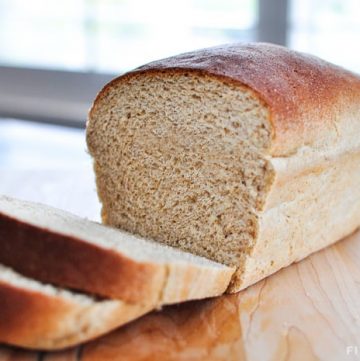
The Very BEST Whole Wheat Bread
Ingredients
Step 1:
- 3 ½ cups white whole wheat flour
- ⅓ cup vital wheat gluten
- 4 teaspoons instant dry yeast, "quick rise" or "rapid rise"
Step 2:
- 2 ½ cups very warm water, 120°F to 130°F
Step 3:
- 1 tablespoon salt
- ⅓ cup coconut oil, melted and cooled (OR vegetable oil)
- ⅓ cup honey
- 4 teaspoons lemon juice
Step 4:
- 2 ½ cups white whole wheat flour
Instructions
- In the bowl of a stand mixer fitted with a dough hook, mix together 3 ½ cups white whole wheat flour, vital wheat gluten, and quick-rise yeast until well combined.
- Add the water and mix for one minute, scraping down bowl halfway through. Cover the bowl with a clean kitchen towel and allow to rest for 10 minutes.
- Uncover the bowl and add the salt, oil, honey, and lemon juice. Beat for 1 minute.
- Add the remaining 2 ½ cups of flour, one cup at a time, mixing well between each cup. Knead the dough in the mixer (still using the dough hook) until the dough pulls away from the sides of the bowl and feels smooth rather than sticky. This usually takes 10 to 15 minutes, but if your dough pulls away and loses its stickiness sooner, it could take as little as 5 minutes.
- Grease two nonstick bread pans measuring 8 ½" x 4 ½" x 2 ½" to 9" x 5" x 3" each (or grease two regular bread pans and then line them with parchment paper). Preheat the oven to lukewarm by setting it to 350°F and then turning it back off after exactly 1 minute.
- Turn the dough onto a greased surface. Evenly divide it into two loaves. Form and place the dough into the prepared bread pans, gently pressing it into the corners.
- Place the pans in the warm oven and allow them to rise for 20 to 40 minutes, until the dough is nicely domed above the tops of the pans. Without removing the pans from the oven, turn on the oven to 350°F and set the timer for 30 minutes. The bread is done when the tops are golden brown and the internal temperature reaches 190°F to 200°F on an instant-read thermometer. Once the loaves are baked, immediately remove the hot bread from the pans to cool on a rack.
Equipment Needed
Notes
- I use coconut oil in this recipe. It works wonderfully and doesn't make the bread taste like coconut at all. However, you may use sunflower, safflower, or another light-flavored vegetable oil, if you prefer.
- Kneading and rising times are approximate and depend on many different variables. The dough must be kneaded until it pulls away from the bowl and is no longer sticky, even if that takes shorter or longer than 10 to 15 minutes. Also, the dough should be allowed to rise in the pans until it is as high as you want your final bread to be.
- White whole wheat flour is 100% whole wheat flour that yields a lighter taste and texture than regular whole wheat flour.
- Other types of flour (regular whole wheat flour, all-purpose white flour, freshly milled wheat flour, etc.) may be substituted for the white whole wheat flour in this recipe. Just keep in mind that the final flavor and texture of the bread may turn out different. Also, if you use an alternate flour (particularly freshly milled flour, which can be less dense), you may need to slightly adjust the amount of flour added at the end of the recipe. For example, if the dough seems extra sticky and doesn't start pulling away from the bowl, you can work in additional flour, one teaspoon at a time, until the texture seems right.
- If you don't have any lemon juice on hand, you may substitute another type of acid in its place (such as white vinegar or apple cider vinegar).
- Vital wheat gluten helps whole wheat bread recipes rise and yield soft and chewy loaves. That being said, if you don't have any on hand or prefer not to use it, many people report having made this bread successfully leaving out the vital wheat gluten.
Nutrition
Recipe adapted from Deals to Meals.
Post originally published on July 8, 2013.

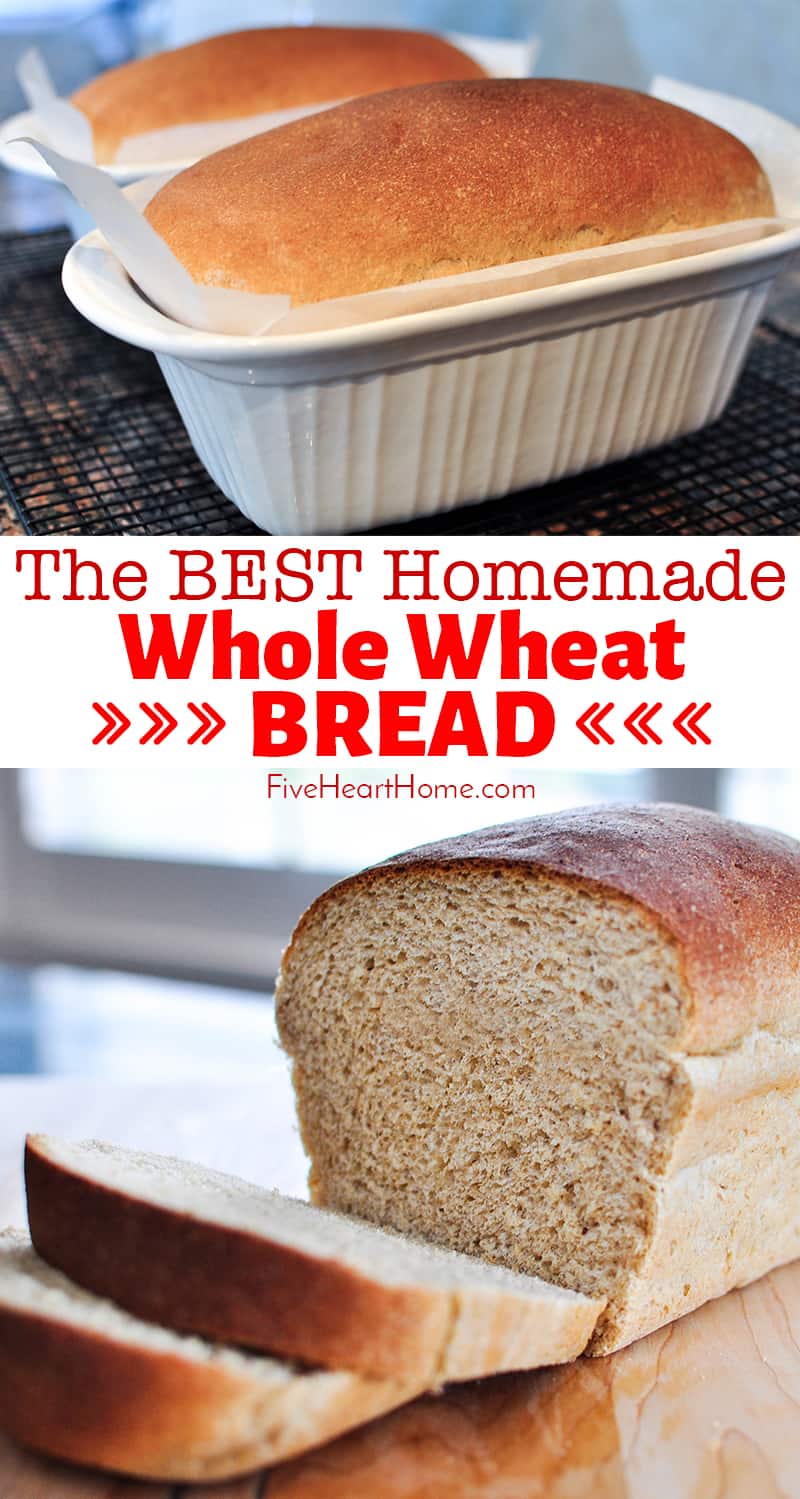
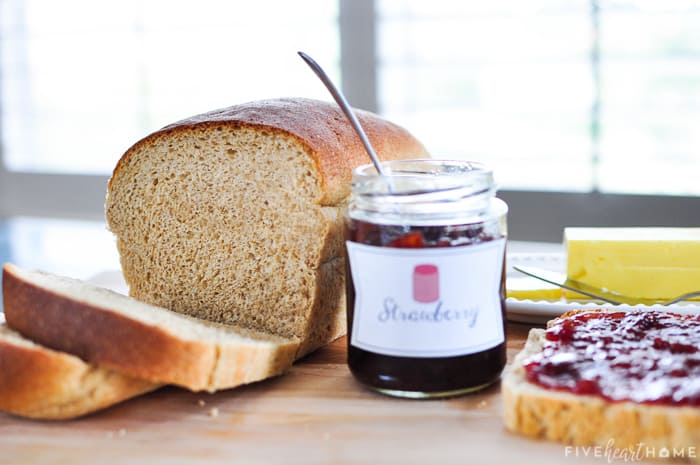
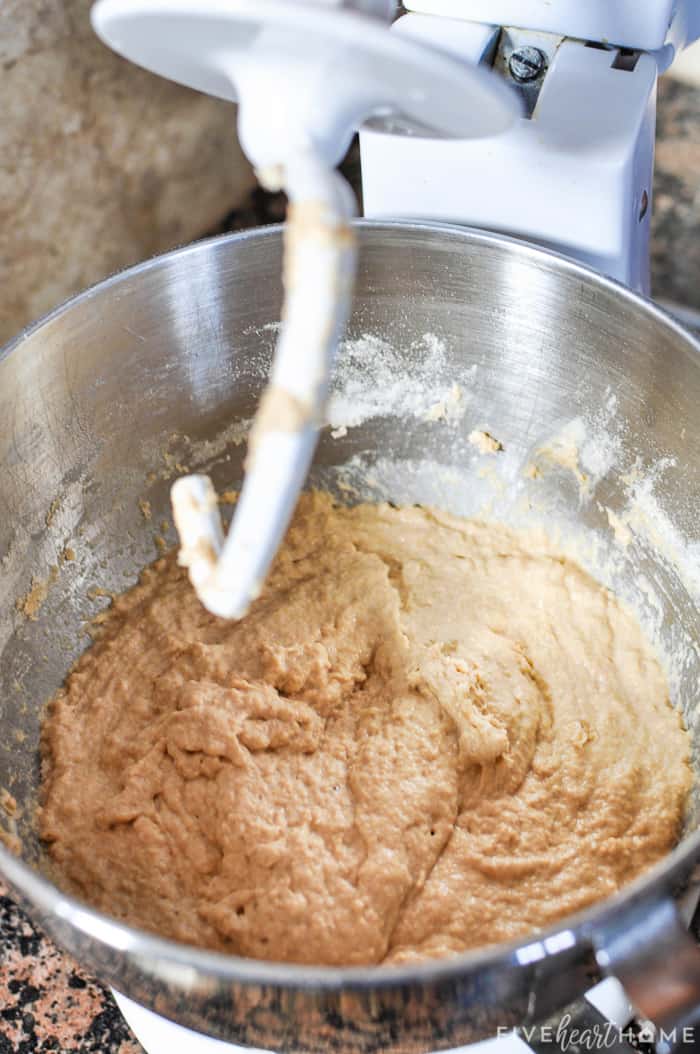 Cover with a clean kitchen towel and allow to rest for 10 minutes.
Cover with a clean kitchen towel and allow to rest for 10 minutes.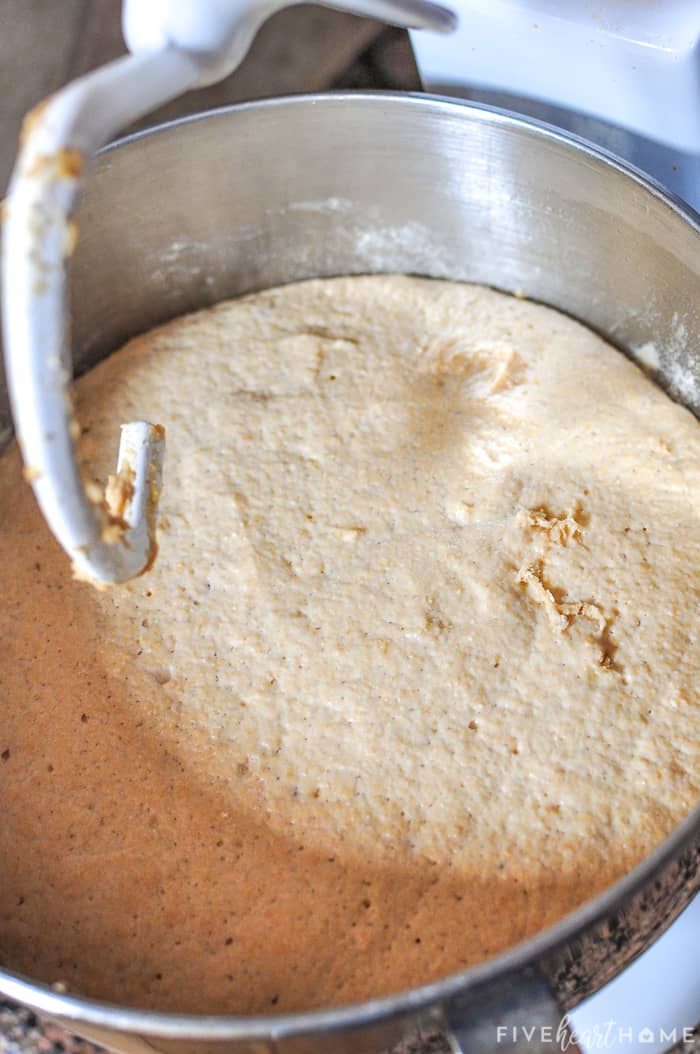 Beat in salt, oil, honey, and lemon juice.
Beat in salt, oil, honey, and lemon juice.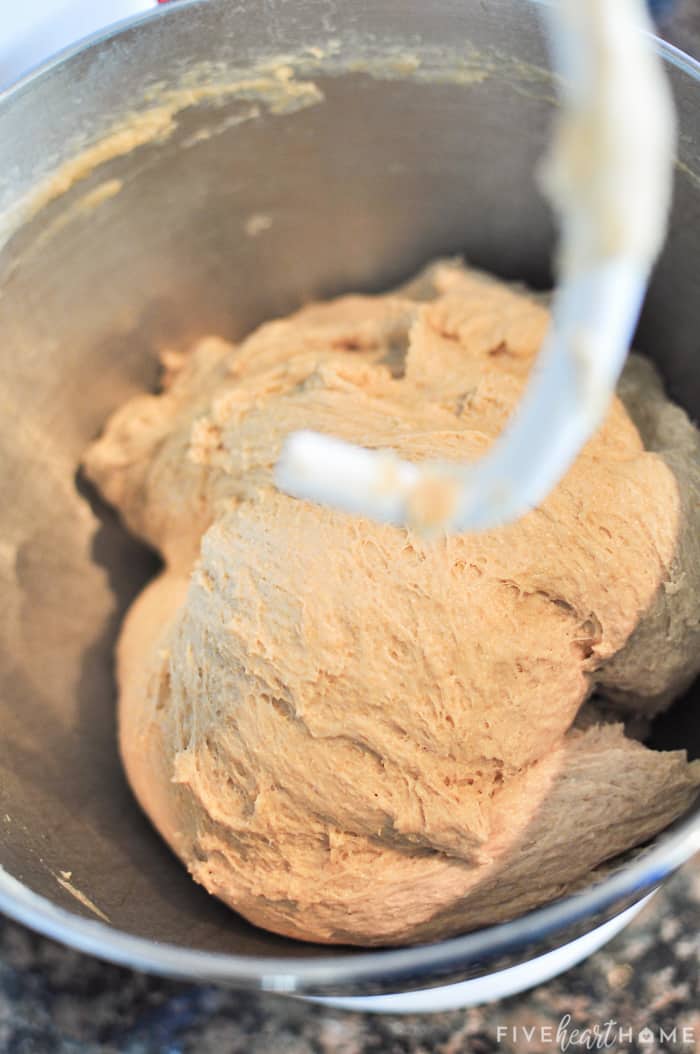 This typically takes 10 to 15 minutes but may take as little as 5 minutes.
This typically takes 10 to 15 minutes but may take as little as 5 minutes.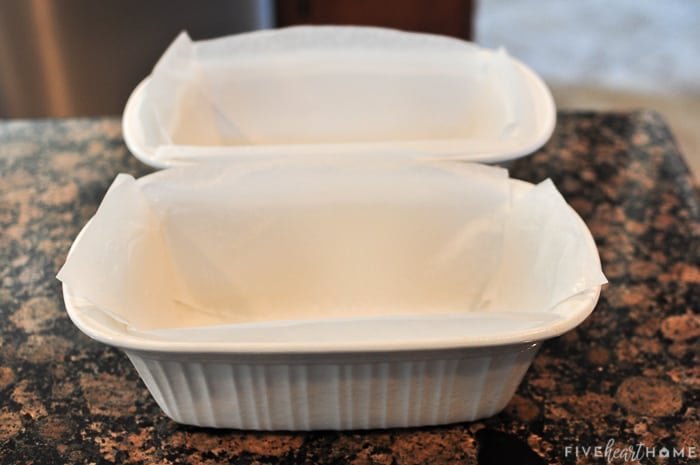
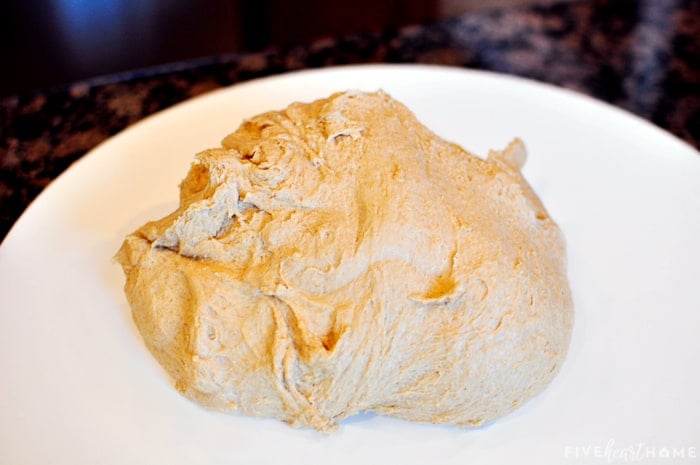 Divide it equally in half and shape it into two loaves.
Divide it equally in half and shape it into two loaves.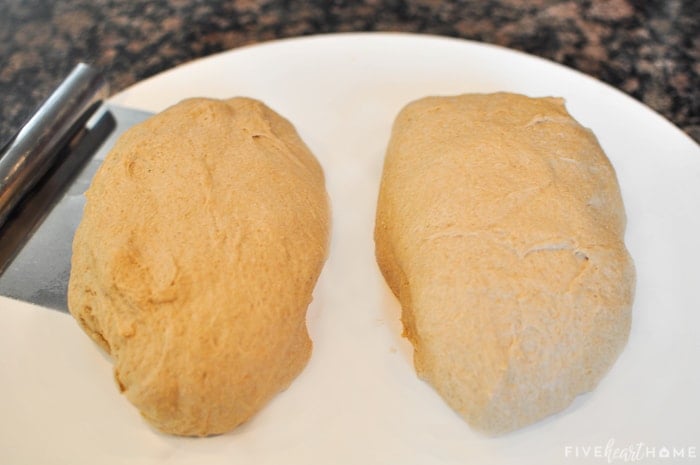 Transfer the loaves to the prepared bread pans, pressing the dough into the corners.
Transfer the loaves to the prepared bread pans, pressing the dough into the corners.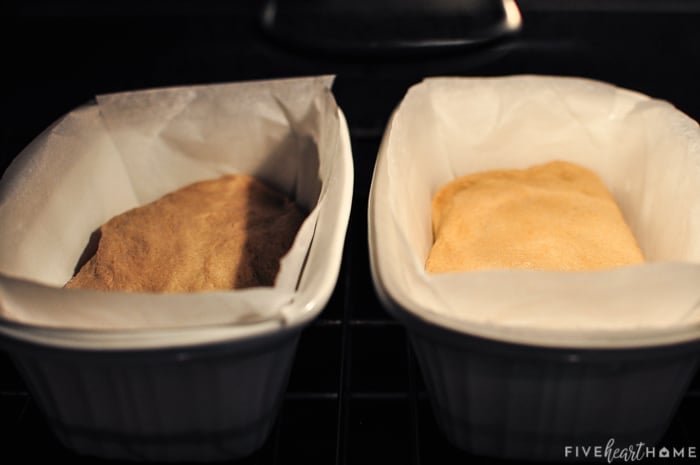
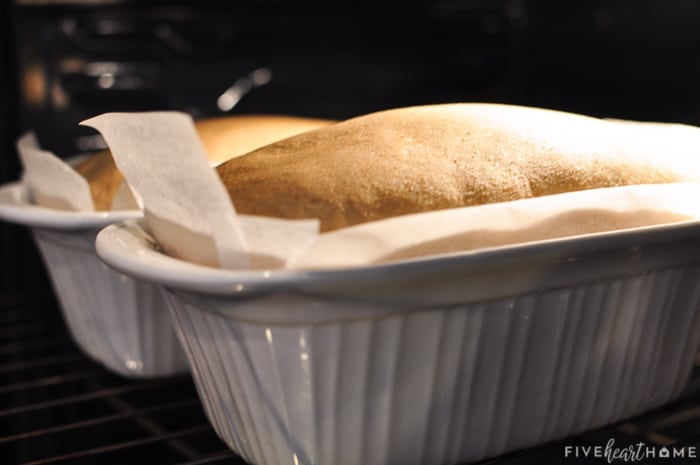
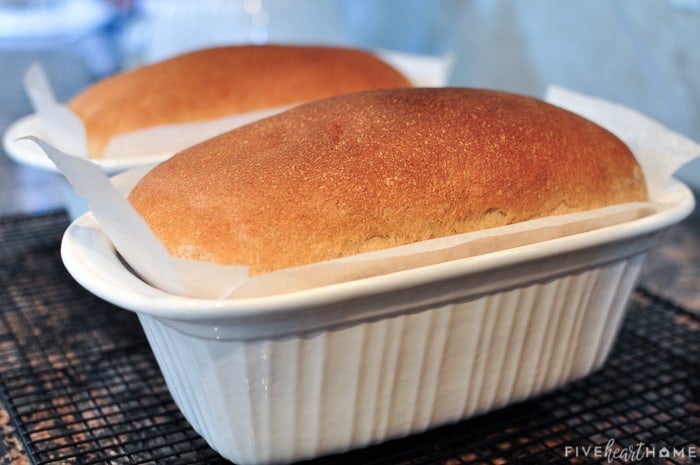
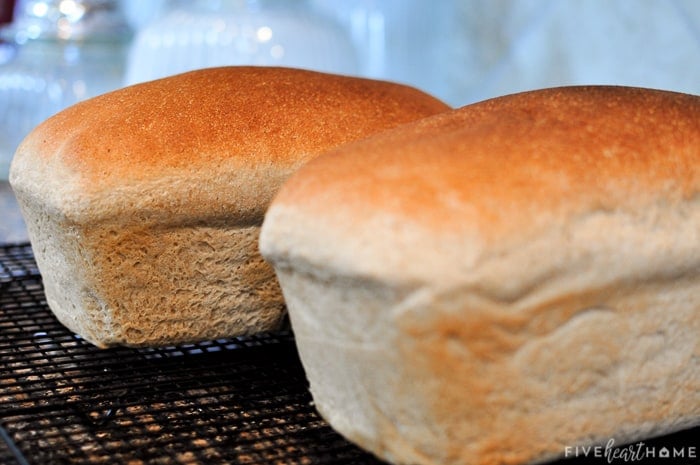
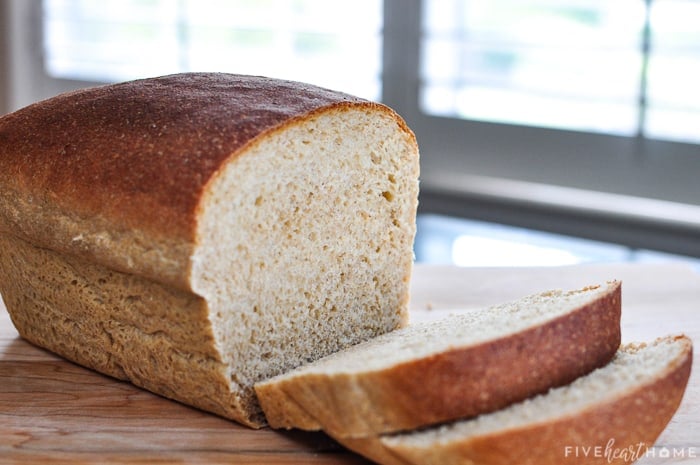
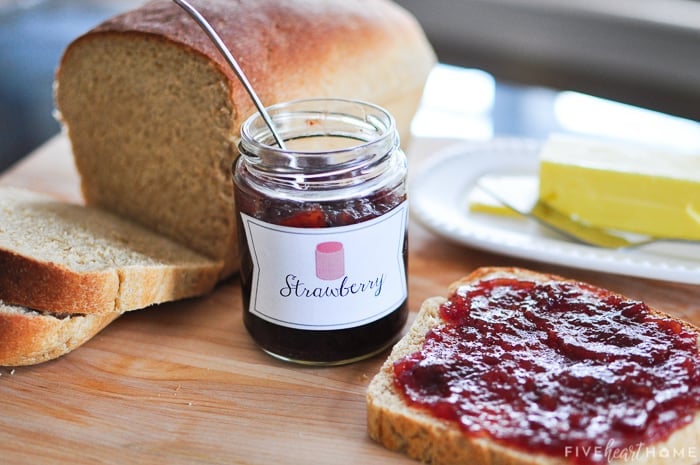
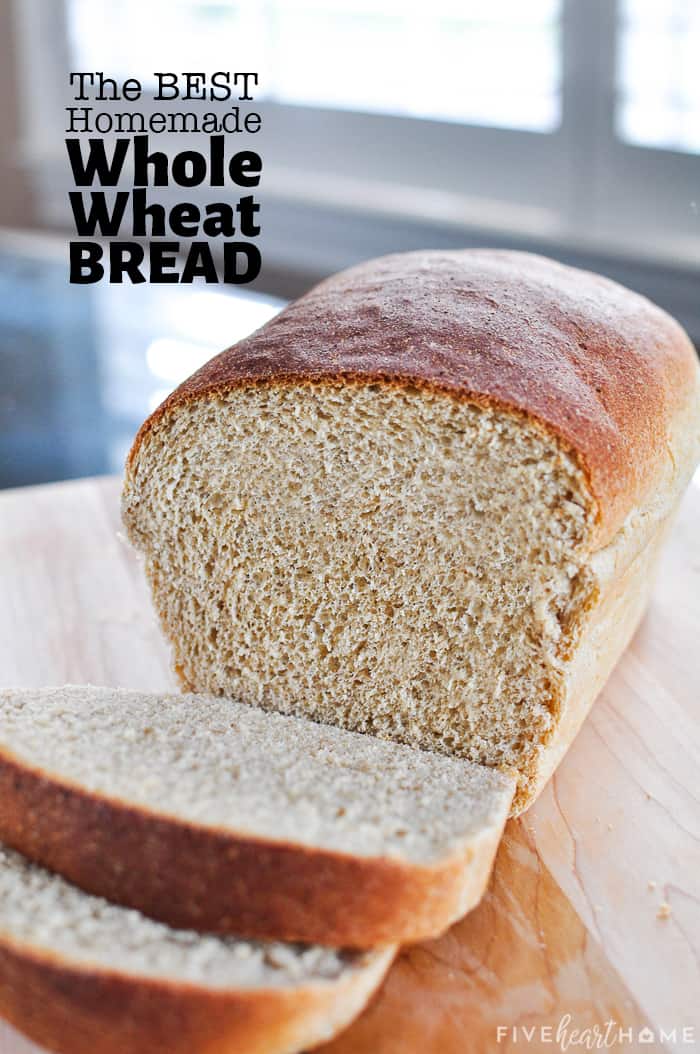
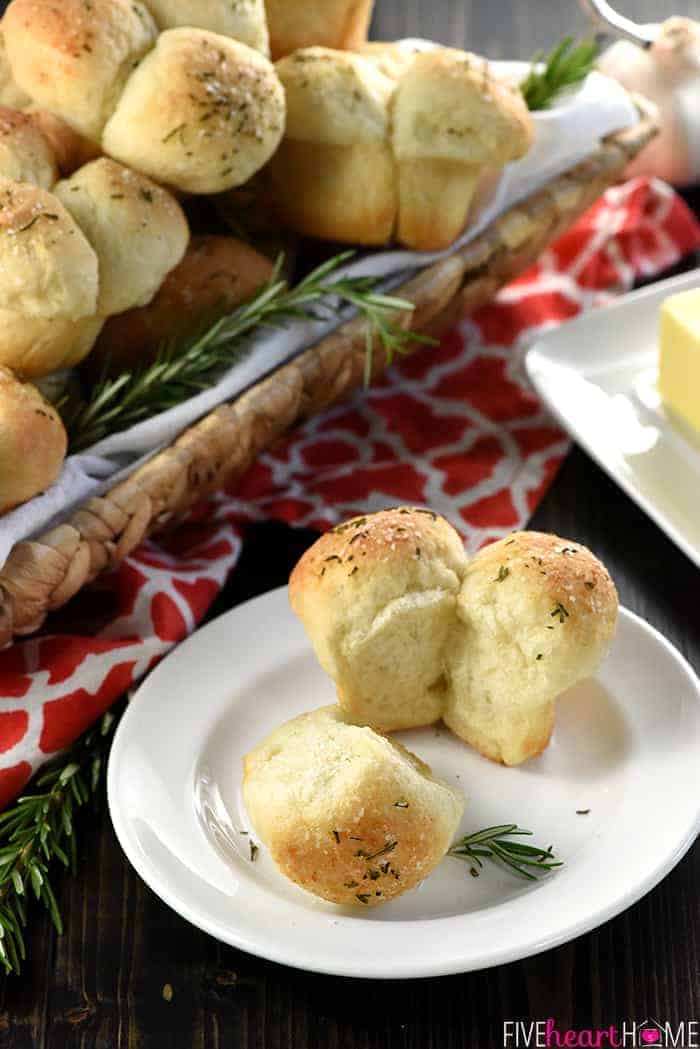
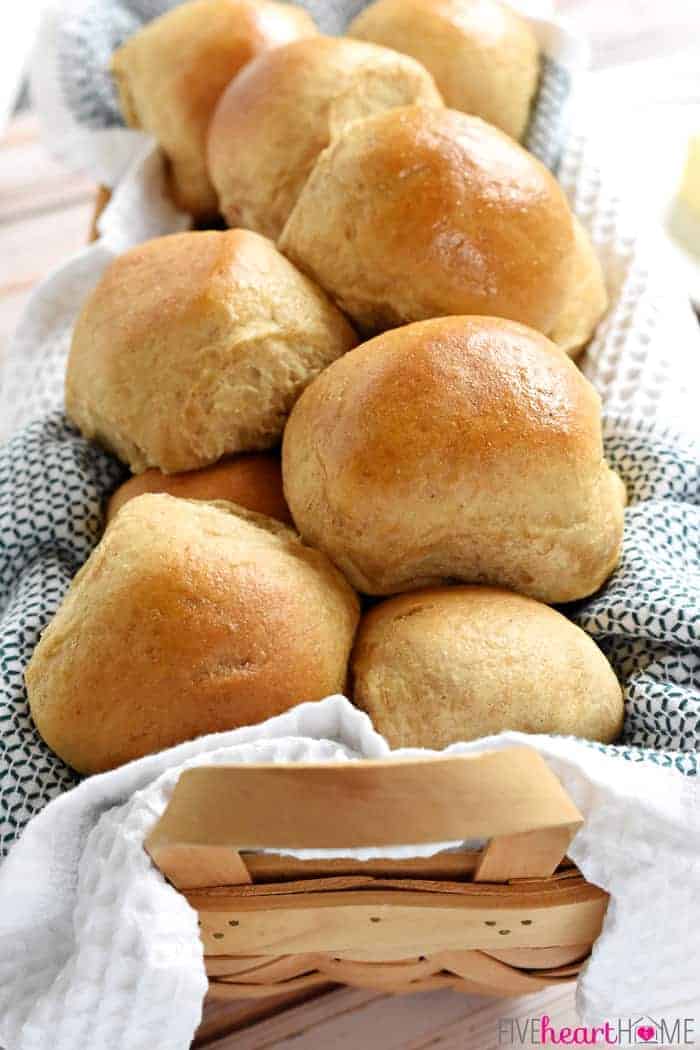
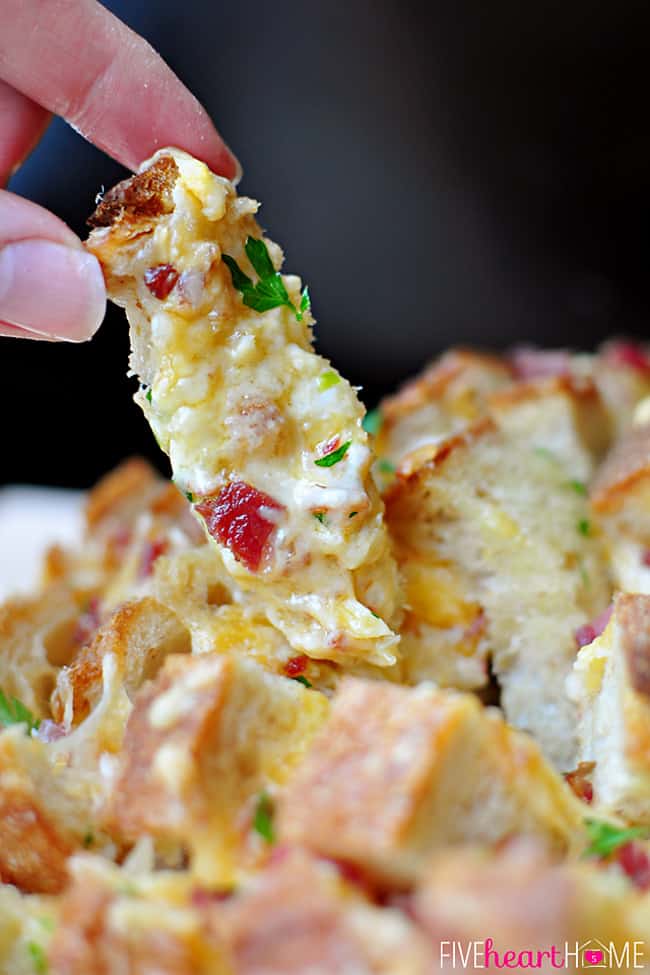
Hello again, thank you for your hints. I wanted to get back with you on my experience baking your recipe. It turned out wonderful! I have tried now 3 whole wheat sandwich recipes and this is my favorite. I did half the honey because I did want a sandwich bread, for grilled cheese, meat sandwiches, etc., so it tastes perfect!! The inside was slightly dry so looking on King Arthur Flour's troubleshooting page I either let it rise in too warm a spot, let it rise too long, or my oven temp wasn't right. I think the only thing I'll change about this is at the very end leaving the loaves in the oven and letting the oven preheat. My oven takes SO long to preheat, close to 30 min so I couldn't effectively bake bread this way. I tried to take the loaves out and one deflated, so not sure if you have any tips for that. I think from troubleshooting it was I let it rise too long and made it too delicate. I have a 22 month old, it's hard to set a timer for anything! 😛 But other than the minor tweaks I love this recipe!!! Thank you for sharing, it turned out delicious!
Thanks so much for coming back with all of your great feedback, Ryann! It sounds like you've done some excellent troubleshooting. I bet this recipe turns out even better for you next time! Sometimes it just takes awhile to figure out the best method for a bread recipe depending on your particular variables...oven calibration, humidity, type of flour used, etc. can all result in a different outcome from kitchen to kitchen. But I'm so glad to hear that you are on the right track and that you enjoyed the bread! And I hear you on the challenges of baking with young children diverting your attention... 😉 I really appreciate you taking the time to come back and share your experiences with the rest of us...have a great week! 🙂
Just wondering if you could give me an idea of how many carbs per slice. My husband and I are both diabetic and count carbs religiously. But I really want to find a whole wheat bread recipe that is light, but doesn't contain too many carbs.
Thanks!
Linda
Hi Linda! I am so sorry, but I'm not a dietician and I have no idea how to calculate carbs in a recipe. Might there be an online carb calculator or something similar that could give you the information you need? I apologize that I can't be of more help. I hope you find an answer from a source that knows more than I do! Thanks for the question, and I hope you're having a great week!
Came across your website looking for just this type of recipe; very excited to try it! I've tried so far 2 different whole wheat bread recipes and they've been good, but too sweet and a little too hearty. I would think 1/3 cup honey would make this in the slightly sweet category; tasting the bread would you agree? It does make 2 loaves though so perhaps that will be okay. I just am looking for a regular sandwich bread recipe, obviously nothing close to raisin bread, etc., but still not too sweet.
Also, what size loaf pans do you recommend? 7.5 X 4.5 or 9x5? Thanks in advance for your advice!
Hi Ryann! I would say that this bread has a slightly sweet undertone...probably similar to honey wheat bread that you would buy at the grocery store. It's not something that I notice as being sweet, but you may if you are sensitive to sweetness in your bread. You can definitely reduce the honey if you'd like!
As for the pans I use, they are stoneware 1 3/4 quart or 1.6 L capacity, and the top of each pan measures about 9" by 5".
Thanks so much for the great questions! I hope you end up enjoying this recipe!
I just broke the rules and sliced off the end of a fresh, still hot loaf, and it was wonderful. Better than any whole wheat I've ever made or eaten. I made it by hand and kneaded for about 15 minutes until it was the texture that I like. I had to bake it a bit longer. Maybe my oven is slow, but it's amazing how you mix all this stuff together, knead, bake it, and it comes out bread! It doesn't matter how it looks at all. Mine sunk a little in the center too, but so what. I loved it. The test will be when hubby comes home from work tonight. White whole wheat is the way to go. I used it at Christmas to make pizzelles and other cookies. It worked out fine and I didn't feel so guilty waiting all those sweets! Thank you so much. You rock. Oh, and you are very pretty.
Hi Anne! I'm so glad you enjoyed the bread! I love white whole wheat flour for baking bread as well. I usually use whole wheat pastry flour for cookies, pancakes, and such, but maybe I'll give white whole wheat flour a try for those as well! 🙂
Thanks so much for your thoughtful comment. I hope this bread is a hit with your husband as well, and hope you're having a great week!
Hello Samantha! Love this recipe! I used it for my first try at homemade bread and it turned out perfectly!! Thank you!!
Oh, I'm so happy to hear that, Laura! Congratulations on your first homemade bread...there's nothing better! 🙂 Thanks so much for taking the time to stop by and let me know that it turned out well. Hope you have a wonderful week!
Best bread recipe! I made my own wheat flour, and mixed in some rosemary in one of the loafs. Thank you!
I'm so glad to hear that you enjoyed it, Julia! And the rosemary sounds like a wonderful addition...I'm going to have to try that next time! I really appreciate you taking the time to come back and comment. 🙂 Hope you're having a great weekend!
Hi Looks yummy! Could you tell me the changes to make to make this in a bread machine please? Thank you!
Hi Margie! I apologize, but I don't have a bread machine so I haven't tried making this recipe in one. A few others have asked the same question before you, and if you scroll through the above comments, I've made a few suggestions for how I would attempt to adjust this recipe if I were making it in a bread machine. Of course, since I haven't actually done so, I can't guarantee how those suggestions would work out! One day someone will come back and let the rest of us know the secret to converting this recipe to a bread machine! In the meantime, sorry I can't be of more help. Hope you get this recipe to work for you if you try it in a bread machine (and let us know if you do!), or if not, I hope you find a comparable recipe to use instead. 🙂 Good luck!
First time ever making whole wheat bread! I have had my grinder for a long time. It wasn't until I found your recipe that I finally got the bug and got it out. It turned out sooo good! Thank you!
Yay, Kirston! I am so happy to hear that! One of these days I'm going to get a grinder to grind my own flour. With that fresh flour, I bet your bread turned out even better than mine! 😉 Thanks for stopping by to let me know about your bread making success. Hope you get to enjoy this recipe many more times... 🙂
I got a wheat grinder for Christmas and found this recipe. I have tried many recipes and this is by far the BEST! And I love that it calls for coconut oil and honey instead of sugar and vegetable oil. The coconut oil adds some sweetness to it. This is the only recipe I will make now. Thanks!
I am so happy to hear that, Ahsli! You listed all of the reasons that I love this recipe as well. I'm excited that this bread worked out for you and that you'll be making it again! I appreciate you taking the time to let me know... 🙂
Hi, I made yuour recipe and it was the first somewhat successful attempt at breadmaking I have completed. I didn't have wheat gluted, so I used dough conditioner. My loaves rose ok but the dome deflated when baking. Still it was delicious and hearty. The dough never seemed to get unsticky, should I add more flour or knead longer? I am going to try again with the wheat gluten. thanks again for sharing your recipe. R. Sperling
Hi there! I'm glad to hear that this bread was your best attempt yet! I bet it will turn out even better the next time you try it. 🙂 My guesses for the issues you're describing...if your bread deflated during baking, it could have been because of too much moisture or you may have let the loaves rise a tad too much. If your dough was sticky, that may have indicated too much moisture as well. If you knead for the recommended amount of time and it's still sticky, try adding just a little more flour (not too much!) and kneading for awhile longer to see if that helps. But it sounds like you're on the right track...good luck if you make this recipe again, and thanks for the questions! 🙂
Can you add 2 tbls oatmeal and 1/4 cup of crushed sunflower seeds and walnuts? If so would there be any changes?
Hi Valerie! I'm sorry, but since I have not tried those changes, I'm not sure how they would affect the bread. However, I don't see why they wouldn't work, and I don't think any additional changes should be necessary. If you add them, please let me know how the bread turns out! Have a great day!
Can this bread be done with an egg or two, some milk and most of all by hand?
Hi Michael! Yes, the bread can be made by hand...it's just going to take more time and muscle for all of that kneading! 🙂 As far as your other modifications, I apologize, but I'm not sure how those would affect the bread since I haven't tried them myself. If you do try them, I hope you'll come back and let us know how the bread turned out!
Oh my goodness! I just took a bite of the best bread in the entire world! I am still in shock with how absolutely wonderful this bread is! This was my first time making it and it turned out wonderful! My family and I have just started transitioning into non-gmo, non-processed, and all organic foods and because of you sharing your receipe we can become a healthier family by making our own bread instead of buying packaged bread filled with ingredients that are nothing but chemicals! I honestly cannot thank you enough!
It makes me so happy to hear that, Mrs. Jones...thanks for stopping by and sharing that with me! This recipe has been pretty popular and it seems to turn out well for most people, but I do get some comments by readers who had something go wrong and are looking for advice. Since bread making depends on so many variables, I'm not always sure what to suggest...so I am thrilled to get comments like yours where everything turned out as it should! 🙂
I wish you the best of luck with your family's non-GMO, non-processed, all organic transition, and I'm glad that this bread will help you achieve those goals. I try to stick with organic, real food as well for my family...it seemed overwhelming at first, but you figure it out pretty quickly! 😉 Thanks again for taking the time to leave a comment...have a great weekend!
Mine turned out cakey in some parts??? Am I doing something wrong? Not let it rest in the oven long enough before I start baking? Will try again. Otherwise, really good!
I really wish I could help, but I'm not sure what you mean by "cakey" in this instance. Like parts of the bread were dense while the rest was fluffy? There are so many variables that go into bread baking that it could have been a variety of factors...measuring your ingredients carefully, humidity of the air, allowing dough to rise long enough, etc., etc. If you try it again, I'd be interested to hear if the same thing happens!
I'm so sorry I can't be of more help. This recipe has consistently worked for me, which is why I shared it in the first place. But that means that sometimes I'm not sure what to tell people when they have problems because I haven't experienced any with this recipe! I hope it comes out perfect for you next time...good luck! 🙂
I'm betting you added to much flour. This often results in a "cakey" texture even is the rise is good.
awwwww. . . i was reading with sooo much excitement until I read "vital wheat gluten". I really dont want to add more gluten. So hard on my tummy 🙁 BUT wonderful post, so clear and the pictures of the loaves look so yummy !
Hi Farzana! If you are sensitive to gluten, you can certainly leave out the vital wheat gluten. It serves to enhance the texture and elasticity of this bread, but I'm willing to bet that the bread would still turn out pretty darn good without it... 🙂
Hi, thanks for the recipe. I have made this twice and have had the same problem both times. Once they rise above the pan to the correct height I turn on the oven as you advise and after a couple of minutes they sink a bit in the middle. Do you know what I'm doing wrong. They still taste DELICIOUS and the kids love it! I would just like to make them without sinking. Thank you!!!
Hi, Effie! I'm so sorry you've had a problem with sinking bread! I've not had that experience with this bread, though it has happened to me with other recipes. I'm not a bread-baking expert, but I do know that making bread can be very temperamental based on many different variables, so I'm afraid I can't tell you specifically what's been going on with your bread. In trying to find a solution for you, however, I came across a pretty good link with questions and answers as to what might be going on with your bread: http://community.kingarthurflour.com/content/why-does-my-bread-fall-oven . Maybe one of these suggestions will strike a chord with you? Hope you're able to figure it out and get bread that stays nice and domed on top!
Thanks so much for the question...hope you have a great Thanksgiving!
Hi Samantha!
I've made this recipe many times but lately my bread sinks in the middle and I can't figure out what's going on. I went through all the comments to find someone with a similar problem and found that someone else also has the same issue. Still stumped and I'm afraid to make it again. I used Baker Josef's 100% White Whole Wheat Flour from Trader Joe's, organic coconut oil (I melt it first and cool it before adding), organic raw honey. Also I find that I have to add a little more flour as my dough doesn't pull away from the sides of the bowl. Other than that the bread is delicious but funny looking.
Would like to know if anyone else has had this problem and if you or anyone has any suggestions.
Love your site!
Thanks
Thanks
Hi Sonia! I'm so sorry to hear that you've started having problems with this recipe. But the fact that you've made it many times successfully makes me think that something has changed with your ingredients or method? Is it possible that your yeast is old and may have lost its potency? Or could you be adding too much yeast (or letting the bread rise too long), which can cause it to over-rise and then sink? Have you checked your oven temperature/calibration? Sometimes bread sinks because there is too much liquid that can't be absorbed, and maybe this could be the issue if you're having to add more flour? But I don't know why that would have changed if you previously this bread with success. Anyway, I'm sorry I can't be of more help...there are so many variables that can cause a bread recipe not to work, but hopefully you're able to figure it out. Good luck and keep me posted! 🙂
Hi! I've been grinding my own wheat (soft and hard white) for several years now and love bread making! I've tried many different recipes seeking to achieve that light and fluffy store bought texture. Not an easy task--home milled flour is very finicky! I was excited to make your recipe since I've not heard of the "sponge" technic before. Overall, I had success! I ended up with nice high loaves that are definitely soft and moist. However, the bread is just a bit on the tough side. I'm thinking that I may have over kneaded it. Is that possible? After 15 min. of kneading the dough still seemed very sticky to me, so I continued for another 10 to 15 min. This recipe is definitely a keeper and I'll be giving it another try. Thanks for sharing!
Hi Karla! I am not experienced with fresh ground wheat, though I think it sounds wonderful and I hope I'm able to start using it one day! So I'm not sure if the fresh flour could be a factor in your problem. I have never had this bread turn out tough when I've made it, but I just did some research that says that over kneading actually can lead to tough bread. So maybe that was it? But I'm with you...when the dough is still sticky, I keep kneading. Did you knead by hand or with a mixer? I think it would be very hard to over knead by hand. If you used a mixer, maybe just shave off some of the additional minutes next time? I wish I could be more help. I don't consider myself a bread making expert by any means, but I have a few tried and true recipes that turn out well for me and this is one of them. I hope the issue is resolved when you try it again...I'm glad that the bread at least rose well for you and turned out soft and moist! Thanks so much for the question... 🙂
Thank you for your reply and doing that bit of research! I did knead the dough with my mixer. It never did pull away from the sides of the bowl even after 30 min. of kneading. So next time I'll be sure to stop at the recommended time and I'll bet it won't be tough. 🙂
I've been thinking about it some more, Karla, and I wonder if fresh ground flour measures a little bit different than store bought flour? Since it's bound to be lighter and fluffier, maybe you just need to use a bit more for this recipe? I know that adding too much flour can make your bread tough as well, but the dough really should be pulling away from the bowl before hitting 30 minutes of kneading! So maybe adding a little more flour would resolve the problem? Just a thought...like I said before, I'm no expert! 🙂 But if you figure it out, please come back and share what ended up working for you! Have a great week!
I tried this recipe today for the first time and used fresh stone-ground flour. I noticed it wasn't pulling away, looked through the comments and came across this one. I added just slightly over half a cup more of the flour part-way through the kneading time (when I realized that it wasn't working out) and it pulled away beautifully! After the 15 min total kneading time the dough was still slightly sticky but easy to handle. I let mine rise a little longer (probably closer to an hour) and the baking time was right on. The loaves are cooling right now and I haven't tasted yet, but they seem to be light and fluffy and they look and smell AMAZING! 🙂
Thank you so much for your comment, Leanne! It will be very helpful to others using freshly ground flour. I suspected that the measurement might need to be slightly tweaked in that case, but I hadn't tried it myself so I wasn't sure by how much. Your experience will help countless others who run into the same issue. I'm so glad that your bread turned out and I hope you are enjoying it! It never lasts very long at our house... 😉 Have a great afternoon!
Thanks for the great recipe! My daughter and I tried it last nite for the first time, and now I need to go toss all my other whole wheat recipes! The only issue we had was the loaves fell a little, but I think we may have cut the kneading time a little short and also may have let them rise a little too long. The only suggestion I would make, and it might help some of the posters having problems with different flours, is if the recipe was converted to weight-based. That pretty well eliminates density issues, etc. Over time I've converted all of the recipes I use frequently and it really helps. Thanks again!
I'm so glad that this recipe was a hit with your family, Pete! Your idea to convert these measurements to weight-based is a great idea...thank you for the suggestion! I will work on that the next time I bake this bread. 🙂 I appreciate you taking the time to comment...hope you're having a great week!
So, after several months of (finally) consistently turning out high, light and fluffy loaves I thought I'd come back and share what I've learned. I home mill my own hard white wheat and I was having issues with the bread ending up a little on the tough side. I finally had to start thinking "out of the box" on this one! What I discovered is that when I stopped trying to get my dough to be non-sticky and pull away from the sides of the bowl, I had success! With flour that goes right from the mill and into the bread I think you don't want to do that. So with that in mind, I went with less flour (about 1/2 cup less) and I kneaded my dough for 20 min. after the initial "sponging" and then stop regardless of what the dough looked like. (And believe me, when you look at it you think, "This is never going to work".) However, the dough rises beautifully. It is very limp with almost no "body" to it after it's punched down, but turned out on a lightly floured surface you can get it into the loaf pan with no problem. I also double the amount of yeast. Hopefully, this is helpful to those who are working with freshly ground flour!I
I really appreciate you sharing that, Karla! Your experience is sure to be helpful to others who grind their own wheat. Thanks for taking the time to stop by and share your knowledge! I'm so glad you're enjoying your bread after some trial and error. 🙂 Hope you have a great week!
I am trying the recipe (doubled) for the first time today, and I too was using freshly ground flour. I ground 9 cups of grain, which would yield about 13.5 cups of flour, but the flour is so light and fluffy that after adding what looked like 12 cups total (7 in sponge, 5 in kneading) I could tell that I had more than 1.5 cups of flour left, so I added about a cup more. I too kneaded for 10 -15 minutes and still had really sticky dough, so I added the rest of my freshly ground flour and kneaded about 3 minutes longer. That wasn't really enough to develop the gluten from the newly added flour, but I didn't want to over knead. The loaves rose beautifully and are baking now; I'll report back later. For reference, I am using a Electrolux/Magic Mill DLX/Assistent mixer. Oh, I also didn't use all white wheat as I ground before I chose my recipe today, so it was 2/3 red wheat and 1/3 white/golden wheat.
Thanks so much for sharing your experience and adaptations with us, Kimberly...I'm sure your comment will help someone else! 🙂
I just made this bread recipe a few days ago. I also used fresh ground flour (spelt) . I added an extra 1/2 cup to 3/4 cup while the KA mixer was kneading. Then after about 8-10 min it started to pull away. I didnt think that it would, but it did. Then I let it knead for about 5 minutes more. Everything came out great. I was a little nervous about letting it rise once, and keeping it in the oven before it preheated, but it was perfect. It went against all the common bread rules, but my family of 7 loved it!
So happy that everything worked out and that y'all enjoyed this bread, Ashley! I appreciate you taking the time to share your experience. Hope your week is off to a great start!
I made this bread yesterday and it was great except that for some reason the center closes to the bottom did not cook. Put it back in the oven and tried to cook it for almost two hours still it did not cook. Got any idea what happen. I'v made quit a bit of bread in the past years and never had this problem.
Hope you can help, love the texture.
I'm so sorry to hear that your bread didn't turn out perfectly, Janice! I've never had that happen to me with this recipe, nor have I heard of it happening. Clearly something was going on if the bread still wasn't cooked after 2 hours! Since you have experience baking bread, you know that the outcome can be dependent on so many things...freshness and temperature of your ingredients, humidity in the air, variable heat from the oven, etc. etc. Sometimes if you cut the bread while it's still warm, it can appear soggy in the center even though it is actually cooked through. You can always use a thermometer to test the internal temperature of your bread before slicing into it, to make sure it is done. I hope that this was just a fluke and that this recipe works out for you if you try it again. I'm sorry I can't be of more help...this one has me stumped!
I had this problem the first time I made it. I think the problem was not enough baking time once the oven reached temperature. So instead I take it out after rising, preheat to 450 then bake ten minutes, lower to 350 and set timer to 30 minutes. You get a nice crisp crust too. That's from a recipe I used to use in Joy of Cooking. When I left bread in while the oven preheated and used that time as part of my 30 minute bake time, it just didn't get done. But that's probably a difference in ovens.
Thanks for sharing your experience, Beth! Different ovens can definitely yield different results, so I'm glad that you were able to figure out the best method for your particular oven. :)https://www.fivehearthome.com/wp-admin/edit-comments.php#comments-form